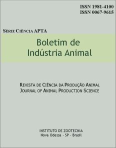Turnover of δ13C replacement of diets with different photosynthetic, cycles eggs in japanese quails eggs (Coturnix coturnix japonica)
DOI:
https://doi.org/10.17523/bia.v71n4p303Keywords:
Isotopic dilution, eggs of japanese quail, C3 and C4 plantsAbstract
The study aimed to evaluate the turnover of 13C by replacing the C3 photosynthetic pathway diet to C4 and C4 to C3 in eggs of japanese quail (Coturnix coturnix japonica) using the technique of stable isotopes. Two hundred and sixteen japanese quail, 50 days old, distributed in a completely randomized experimental design with two treatments in six replications, in an experimental period of 48 days, were used. Prior to 50 days of age, half of quails consumed diet based on C4 plants (corn) and the other half based on C3 plants (rice), both containing meat meal and bone meal. There was replacement of those diets during the experimental period, C3 based diet to C4 and C4 to C3. A total of six eggs were collected from each treatment per day, according the quails age: 50, 51, 52, 54, 57, 60, 64, 68, 73, 78, 85, 91 and 98 days. To determine the turnover rate, the exponential model of isotopic dilution was employed. The experimental time of 48 days was enough for the total turnover in the eggs, with the incorporation of 99% of the carbon atoms of the new diet. The incorporation speed was slower when replacing diets were from C3 to C4 than C4 to C3, which can be explained by bromatological differences of the ingredients.Downloads
Downloads
Published
Issue
Section
License
Os autores não serão remunerados pela publicação de trabalhos, pois devem abrir mão de seus direitos autorais em favor deste periódico. Por outro lado, os autores ficam autorizados a publicar seus artigos, simultaneamente, em repositórios da instituição de sua origem, desde que citada a fonte da publicação original seja Boletim de Indústria Animal. A revista se reserva o direito de efetuar, nos originais, alterações de ordem normativa, ortográfica e gramatical, com vistas a manter o padrão culto da língua e a credibilidade do veículo. Respeitará, no entanto, o estilo de escrever dos autores. Alterações, correções ou sugestões de ordem conceitual serão encaminhadas aos autores, quando necessário. Nesses casos, os artigos, depois de adequados, deverão ser submetidos a nova apreciação. As opiniões emitidas pelos autores dos artigos são de sua exclusiva responsabilidade. Todo o conteúdo deste periódico, exceto onde está identificado, está licenciado sob a Licença Creative Commons Attribution (CC-BY-NC). A condição BY implica que os licenciados podem copiar, distribuir, exibir e executar a obra e fazer trabalhos derivados com base em que só se dão o autor ou licenciante os créditos na forma especificada por estes. A cláusula NC significa que os licenciados podem copiar, distribuir, exibir e executar a obra e fazer trabalhos derivados com base apenas para fins não comerciais.













